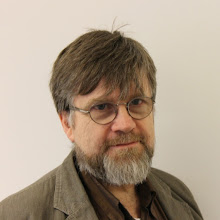This board, almost exactly the same size as the 20*4 LCD display it replaces, also accommodates the rotary encoder and pair of push buttons that allows the user to interact with the radio for tuning and navigation of the simple "menu" system. That's "job done" - because it will allow the entire shebang to be packaged up as a small system, ready for portable operation, which was my goal.
The "rotary encoder and push buttons" combo used to be provided by one of my plug-in tuning modules, so the new board is actually a combination of a quintuple version of the level converter and a tuning module.
After my last post, Tony, g4wif, reminded me how many people run these "Nokia" displays directly from 5V, with either no level conversion or with simplified interfaces (such as resistors). In truth, I have no first hand knowledge of how dire the consequences of 5V operation of these displays would be (in terms of reduction of life of the device, which some writers claim). However, for the price of the level converter, I prefer to do it right.
My level converter follows my previous recipe - only this time I exploited the greater space available to use 2N7000s in TO-92 packages, rather than the original, surface-mount BS138s, as this substitution both simplified the board design and saved pennies.
Here's the schematic...
Here's the copper side of the populated board - notice I used some surface mount resistors (down at bottom right) for convenience...
The component side of the board has little of visual interest when the display is unplugged...
You can't even see that I hadn't any through-hole tactile switches in the junk box - so had to improvise with SMD devices...
I soldered single core wire links between the holes seen on Cu side and then soldered the switches to these wires on the component side. I think I got away with it; the wheeze has worked both mechanically and electrically.
Before you run away with the impression that everything in the garden is smelling of roses, let's remember the downsides we've already confronted (the congestion in the code and in the I/O pins) and acknowledge another downside...
The new display is small - that's the point. But it also displays fewer characters than the 20*4 display it has displaced. It can display 6 lines of 12 characters - 72 in total. On paper, that is more than a 16*4 LCD. But to make a useful, readable display, I'm using rather less than that. So this little Nokia is something of a step down in visual richness than the larger LCDs. "There ain't no such thing as free lunch", or so we are told.
To deal with this reduction in available characters, my software re-formatted the display slightly. For a start, I didn't bother displaying the Mode - as the Occam's Dirk rig is CW only. The remaining display (in normal operating format) appears as seen below...
I have moved from displaying the frequency in MHz (with attendant formatting problems associated with the decimal point) to working directly in Hz. I'm sure this has contributed to the speed and smoothness of the display and I will think about retro-fitting this to the code for all the other Occam's Rigs, the Parallel Rig and the VFOs.
Also, the particular digit being indexed by the rotary encoder at any time - thereby controlling the tuning speed - is indicated by the cursor seen below the numeral "7" in the image above. This moves left or right when the respective buttons are pressed, according to a variable in the code called "dfindex" (explaining why I've labelled it with this name in the photo). The active digit used to be indicated by a blinking digit in the LCD - I prefer this underline "cursor" approach on the new Nokia display - it is easier on the eye. It also makes a space between the frequency and the row of information below (you couldn't usefully display much information in this row, so using it as a movable cursor helps the overall look of the display).
The rest of the screen will be familiar to anybody who has used any of the previous pieces of software. For example, the banner line showing "Occam's Dirk" in the image above is used to display the Menu structure in Menu Mode and the space between this banner line and the frequency display line is used to display variables such as RiT.
With the introduction of the new board, this really is a neat little package now - a stack of shields, a short stack of filters and the new user interface. Trouble is - as ever - it is so much fun as a working rig here on the bench that I just don't seem to be able to get round to that last step of putting it in a box!
...-.- de m0xpd







An interesting post, I found some of your tasks quite intimidating. As an amateur "messer" of electronics, I thought what you did was pretty cool. Using the Nokia display may be a bit smaller than other types but I think the overall efficiency will make it worth it. Working in Hz is also a great idea.
ReplyDeleteRaymond @ CKS Global Solutions LTD